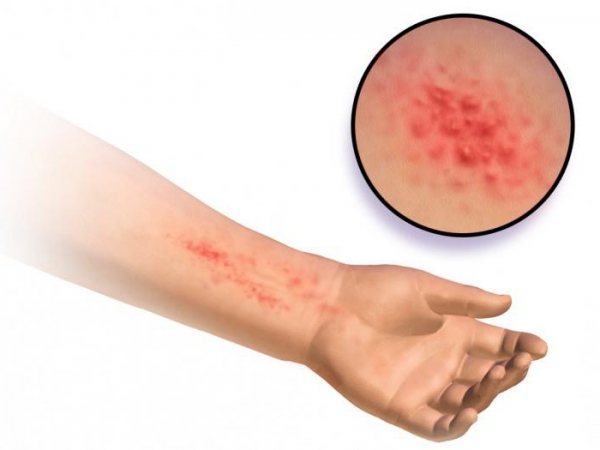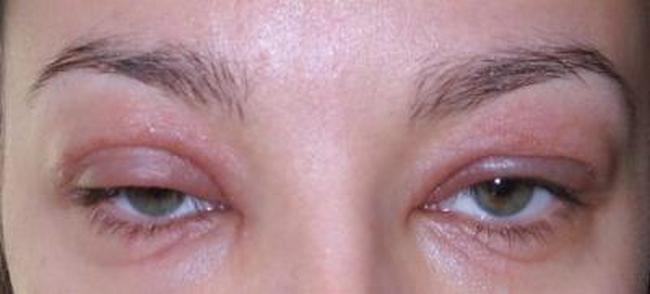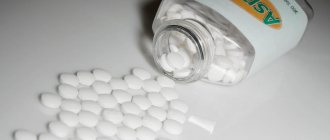Some people have such a condition that irritation forms on their hands. For example, when wearing silver rings from Umax, chains or metal watches. This condition can be caused by a pathology - an allergy to metal. It occurs quite often and consists of the body’s reaction to metal ions, which subsequently bind to proteins.
The most common manifestations are redness, itching and burning sensation, and local swelling of the skin.
Causes of metal allergies
Often, an allergy to metal manifests itself in people living in environmentally polluted settlements of industrial cities, the air of which is filled with exhaust gases containing half of the periodic table.
However, hypersensitivity develops only to certain metals and is caused by a genetic factor. Allergenic substances can accumulate in the body for a long time, but one day the allergy will manifest itself upon contact with metal.
Metal allergy: symptoms and treatment
An allergic reaction to jewelry occurs much less frequently, but to reduce cost, metal impurities are added to jewelry, so an undesirable reaction is possible even to gold and silver items.
Sometimes wearing chains and bracelets does not cause painful symptoms, but an allergy appears to precious earrings, especially in the navel, tongue, and intimate areas, not only in the form of skin hyperemia, swelling and itching, but also an inflammatory reaction and rejection of a foreign body. The pathological process is caused by the addition of copper, nickel, cobalt, gallium, chromium, molybdenum, and beryllium to the precious metal.
Fact! There is no allergy to high-grade gold, silver and the noble metal platinum.
Most often, allergies are expressed after a person comes into contact with the following metals:
- Nickel is used to create many items of clothing, jewelry, medical instruments, and nickel alloys.
- chromium is used as an anti-corrosion and decorative surface treatment. When penetrating into body tissues, it contributes not only to the occurrence of an allergic reaction, but also to toxic compounds (for example, chromic acid salts),
- aluminum used to be a widely used metal for the production of tableware, but recently the use of aluminum in everyday life has been reduced. Aluminum chloride is found in antiperspirant deodorants and other cosmetics.
- Zinc metal is popular in the dental industry for making filling materials. Zinc compounds are components of some ointments and cosmetics.

Causes of allergy to metal :
- low levels of immunity,
- age,
- allergen activity,
- hypersensitivity to a certain metal,
- frequent stress, increased fatigue, excessive irritability.
Note! Many people believe that cobalt and mercury also cause allergies. When a person comes into contact with these metals and mixtures of chemical elements, allergic symptoms actually appear. However, irritation and inflammation of tissues is not caused by allergies and hypersensitization, but by the toxic properties of metals.
Surgical steel. Properties and Application
Steel was first used in surgery in 1666.
Hieronymus Fabricius used an alloy to fix the fracture. The doctor secured the bones with steel rings. In the tools of doctors, the combination of iron and carbon was also present in the Roman era. But then steel was not improved, there was only one formula. The photo shows a bracelet made of surgical steel
In the 21st century, dozens of varieties of alloy are produced. Various additives change its properties. Several grades of the composition are used in medicine, hence the name surgical steel . Let's find out its composition and properties.
Properties of surgical steel
So, there is no “surgical steel” brand. This is a general name for a group of alloys used for the production of medical equipment, instruments, and parts for prosthetics. The main requirement is that the steel should not be porous.
The holes make it difficult to disinfect appliances, making them a breeding ground for bacteria. The alloy should not rust. Therefore, for example, grades of surgical steel U7A and U9A are discarded. They are not resistant to corrosion.
Surgical stainless steel is also distinguished by its hardness. The material must withstand impacts, not scratch or crumble. Hardness allows the tool not to become dull for a long time. In addition, you can make the thinnest possible blade or part without fear that they will bend or break.
Manufacturers and exposure to chemicals are excluded. The alloy, as they say, is inert. Put it in either acid or alkali, steel will not react with them. The material does not react with the body. The alloy is non-toxic, although it contains chromium or nickel. Add manganese and chromium to the mixture of iron and carbon.
The photo shows surgical steel tunnels
Examples of brands: - 40X13, 65X13, 95X13. Products made from surgical steel from foreign manufacturers can be marked, for example, as follows: - SUS440C, AlSl420. The designations in the West are different, but the composition of the alloys is the same.
Application
Steels used in medicine also find “work” in other areas. Thus, the AlSl430 brand is also called food grade. It contains a lot of chromium and little carbon. They are used in medicine to a limited extent due to their high plasticity. But the material is excellent for creating containers; it is easily stretched, stamped, and perforated.
The food industry also includes the production of kitchen utensils. This is also where surgical steel comes in handy. It’s unlikely that anyone will want to buy cabinets with rusting fasteners and handles. Washing machines also require stainless steel. It is also needed in trays for dishwashers. The dishes themselves are made from alloy. The emphasis is on its strength, chemical resistance, and harmlessness.
Surgical steel utensils by cosmetologists' instruments. Nail clippers, scissors, curling irons. All this cannot be done without an iron-based mixture. Architects, builders and designers cannot cope without it.
Many buildings, for example, are designed in high-tech style. It cannot do without metal surfaces. Therefore, houses are clad in steel panels, which gives an industrial look. But what would happen if the shiny surface rusted, broke, or scratched?
In the photo there is a chain with a cross made of surgical steel
The value of surgical steel is also known in mechanical engineering. Most of the alloy is used for the manufacture of accessories for cars, exhaust elements, and heat exchange equipment. Jewelers were not left out either. They make jewelry from the alloy. Surgical steel is used to form chains, earrings, brooches, and bracelets. But we’ll talk about this separately.
Surgical steel jewelry
An example of a jewelry alloy is 316L. This composition is sometimes used for implants implanted into the body. So, a surgical steel chain is absolutely harmless.
Jewelry can become an alternative for people with allergic reactions to gold, silver, and copper. But jewelers value medical alloy for something else.
The composition is ideal in terms of performance, appearance and price.
The bracelet is made of surgical steel and matches the industrial style. Against the backdrop of buildings sparkling with smooth metal and exaggeratedly simple forms, jewels of ornate, sophisticated design sometimes look ridiculous.
Earrings made of surgical steel create an individual image that matches the era. It is also attractive that stainless steel products do not require special care. No need to clean it like silver.
There is no need to worry about scratches on the surface of the jewelry. There are few materials in the world that can leave a mark on medical steel. a surgical steel chain somewhere .
The photo shows a surgical steel piercing
The alloy is not precious. Jewelry made from improved iron - costume jewelry . At the same time, surgical steel is not inferior in properties to precious alloys; for example, it does not rust, like gold. Even in silver it is not recommended to swim.
Steel is not afraid of water. The chemical inertness of the composition is also comparable to platinum group metals. In general, there are a lot of advantages with significant savings on them. It's time to talk about the price of surgical steel.
Price
The cost of a men's bracelet made of surgical steel will be the same, and a sheet of AlSl316L alloy will be different. For source codes they ask from 10 rubles. At the same time, the sheets from the factory differ in thickness. As a rule, they offer samples from 0.1 to 999 millimeters.
The sheets are also damaged when they are cut. For example, 1 by 2 meter plates are offered for 140, 218, 240 rubles. Depends on the manufacturer and the nuances of the alloy formula.
Some sellers set a price tag per kilogram or ton. For example, one of the companies in Nizhny Novgorod sells 1,000 kilograms of 316L steel for 416 rubles. On the jewelry market, this amount can be asked for a bracelet weighing about 30 grams. It all depends on the brand, the complexity of the design, and its compliance with the latest fashion trends.
Regarding jewelry, people most often ask about the cost of piercings. Surgical steel , being in the body, will not cause allergies or other negative consequences. Gold rods can bend, and are not accessible to everyone. As a rule, having made one puncture on the body, people tend to come to the salon again.
It is more profitable to purchase 20 steel jewelry than one precious one. For one barbell made of improved iron you will have to pay only 50-100 rubles. We are talking about 19 mm models without additional elements, for example, stones.
The photo shows a men's bracelet made of surgical steel
Surgical steel remains exotic only among wedding rings. Experts say it's a matter of time. The first samples for weddings have already been released. Newlyweds resort to them because of their special strength.
The wedding ring is worn without taking off. Gold is a soft metal. You have to constantly polish the symbol of love, getting rid of scratches.
Silver rings are covered with niello and do not tolerate moisture. But steel models are the true embodiment of durability and strength of relationships. There is also something sterile in the new trend, indicating the purity of feelings, it’s not for nothing that the alloy is medical.
Reviews
Reviews of surgical steel concern various products made from the alloy. However, in all cases, the majority of the remarks are positive. In kitchenware, jewelry and home furnishings, for example, consumers like cool shine and reliability.
Negative reviews, as a rule, concern fakes made not from surgical steel, but from simple steel. However, counterfeiting is not enough. The price of the material allows us not to lie.
Source: https://tvoi-uvelirr.ru/hirurgicheskaya-stal-svoystva-i-primenenie/
Symptoms of allergic reactions to metal
Allergy symptoms most often do not appear immediately, but after a few days, when metal ions penetrate the upper layers of the skin and cause an immune response to the irritant. The duration of the asymptomatic period depends on factors such as:
- alloy quality,
- sweat gland activity
- sensitivity of the body.
The most common manifestation of allergies is contact dermatitis, which occurs in the area of contact with an allergen metal (plaques, buttons, jewelry).

Allergy to metal products
Symptoms of contact dermatitis are:
- skin rashes, peeling, appearance of crusts at the site of contact with the allergen,
- eczema rash,
- skin hyperemia (redness), similar to a burn,
- swelling of the epidermis,
- bubbles with clear liquid,
- inflammation and rejection of metal implants.
Attention! Cases of allergies have been recorded when eating food that contains nickel, orange juice, dark chocolate, red beans, and peanut butter. Nickel allergy is characterized by a rash on the genitals and anus.
Most often, manifestations of allergies are recorded on the stomach, belt buckle, neck, wrists, ears, earrings, chains, bracelets. In women, metal allergies are noticed on the back and shoulders of the metal parts of the bra.
Complicated symptoms
If you ignore allergic symptoms, erosions and abrasions may form on the body due to scratching and disruption of microcirculation processes in the affected area. The temperature rarely rises due to allergies in the form of contact dermatitis, and there is no general malaise.

Causes of metal allergies
Allergic complications in the form of Quincke's edema also rarely develop. But when such an allergy symptom as angioedema appears, experts refer to intolerance to metal ceramics or filling material with a high concentration of zinc.
Dermatitis may be complicated by a secondary bacterial infection, which is acquired by scratching and damaging the top layer of skin. Also, some workers in the metallurgical industry develop bronchial asthma due to specific bacterial allergens, a consequence of hypersensitivity to metal dust.
Prosthetics and allergies
Allergy to metals in prosthetics is a common occurrence when the following negative symptoms appear:
- signs of stomatitis,
- pain in the mouth,
- metallic taste in the mouth,
- formation of erosions on the tongue,
- inflammatory process on the gums, tongue and lips.

If an allergy to metal occurs, dentists insist on placing special metal crowns:
- zirconium ceramic heavy,
- gold-ceramic ones are highly expensive,
- titanium ceramics are expensive.
Reference! In modern dentistry, there are special devices to determine the patient’s tendency to be allergic to metal before starting prosthetics in order to avoid patients going to court. If the clinic refuses such a service, require the presentation of a quality certificate for the prostheses used, which indicates the composition on the right.
What is Ferrum Lek
Ferrum Lek is a preparation containing iron in special forms - hydroxide with dextran or polymaltosate hydroxide (depending on the release form). These are substances that are closest to the biological compound of a microelement contained in the blood.
Thanks to this, it is well absorbed and assimilated by the body, quickly eliminates the deficiency of the microelement, its symptoms and prevents the consequences of pathology.
Most often, patients are prescribed iron in the form of tablets - injections are used when it is necessary to quickly increase the level of the microelement in the blood.
The product is available in the form of tablets, chewable or for oral administration, syrup, solution for intravenous or intramuscular administration in ampoules. The characteristics of absorption and action of drugs depend on the method of their administration (orally or through injections) - the concentration of the active substance reaches its peak within 3-7 days, the half-life is 3-4 days.
Diagnostics
To diagnose a metal allergy, you should consult an allergist. Often, patients are referred to an allergist by a dermatologist, who sees patients susceptible to contact dermatitis due to contact with metal.

Allergy to metal crowns
A specialist identifies allergies using the following algorithm:
- Physical examination
- Collecting anamnesis from the patient's words,
- Provocative tests, for food allergies, an elimination diet.
Note! If the mucous membranes of the mouth are affected, stomatitis of infectious etiology is excluded. Food intolerance to metals is difficult to distinguish from allergies due to the consumption of other foods; only hypersensitization to nickel has its own characteristics.
Contraindications for use
Contraindications to the use of Ferrum Lek include the following diseases and pathologies:
- hypersensitivity to the components of the drug;
- anemic conditions caused by factors other than insufficient iron concentration in the blood;
- diseases associated with an excess of microelements in the body;
- disruption of the process of incorporating iron into hemoglobin;
- severe disorders of hematopoietic processes;
- first trimester of pregnancy (refers to solution for intramuscular administration).
Ferrum Lek can be taken only for established indications and after confirmation of the patient’s pathological condition by clinical tests. Taking medications containing iron without a doctor's recommendation can cause accumulation of the trace element in the body and serious complications.
Treatment of metal allergies
Treatment of all types of allergies is the same: initially, you should stop interacting with the allergenic substance, and then begin symptomatic therapy. If an allergic reaction is caused by wearing metal products, you should avoid fasteners, buckles, and buttons that provoke the body's immune response.
If you are allergic to cosmetics with metal components, you should avoid this type of cosmetics. If allergic stomatitis occurs due to filling teeth, wearing braces, or installing implants, elements based on metal alloys are removed. Treatment of food intolerance requires correction of the nutritional diet; sometimes it is necessary to change the dishes to ceramic or enamel.
Basic principles of treating metal allergies:
- the use of antihistamines Suprastin, Zodak, Zyrtec, Erius and others. It is recommended to take new generation antiallergic drugs, since the drugs do not cause sedation or drowsiness; one tablet per day is enough,
- application of glucocorticosteroid ointments to the affected areas, hormonal local treatment is prescribed only by a doctor, taking into account the age, severity of allergies, individual characteristics of the patient Advantan, Lokoid, Hydrocortisone, Prednisolone and other weak, moderate, strong and ointments with increased hormonal activity,
- ointments and gels containing retinol, which accelerates cell regeneration and protects the epidermis from harmful environmental influences.
Traditional methods of treatment
Connoisseurs of alternative medicine suggest treating allergies using the following methods:
- apply cucumber, apple, potato compresses to the affected areas of the skin,
- if the skin is peeling, apply a thin layer of homemade fatty sour cream or butter to the affected areas,
- use tinctures of St. John's wort and oak bark,
- take baths with extracts of oregano, chamomile, cornflower, and string.
Attention! The effect of alternative treatment is observed only in combination with traditional medicine. Before using the above methods to get rid of allergies, you should consult your doctor. Herbal infusions are considered strong allergens, therefore, if a cross-reaction occurs, alternative treatment should be discontinued and the doctor should be notified about the deterioration of the condition.
How to treat irritation from a belt on the stomach
As a rule, allergies are characterized by rashes in the form of spots or blisters of various shapes and sizes.
When an allergy occurs as a result of exposure to external factors, the rash looks like spots and is localized precisely at the site of contact with the allergen.
In the case of internal intake of the allergen, the localization of the rash is noted throughout the abdomen, involving adjacent areas of the skin, accompanied by severe burning and itching.
Allergies in a child are manifested by disturbances in the general condition of the body, expressed in tearfulness, loss of appetite, and dysfunction in the digestive system. This symptomatology is especially pronounced when the rash spreads outside the abdominal area.
Often, patients may experience a low-grade (up to 38˚) increase in temperature and general intoxication of the body in the form of headache, increased weakness and fatigue, especially evident during pregnancy. After identifying and stopping the action of the allergen, these symptoms may disappear on their own. However, with subsequent contact, the symptoms can be intensely repeated.
Before starting treatment measures, it is necessary to find out the cause of the development of allergies in order to immediately exclude contact with possible allergens.
Most often, an allergic rash in the abdominal area is provoked by a reaction from wearing a belt, washing powders and conditioners, and synthetic clothing. Therefore, first of all, it is necessary to take water procedures, cleansing the outer layer of the skin, avoiding irritated areas. A small child can be wiped with a damp cloth
Next, you need to take one of the antihistamines (Suprastin, Claritin, Zodak) orally. This will help prevent swelling and neutralize itchy skin.
In addition to internal remedies, there are antihistamines for external use in the form of cream, gels and ointments. They are based on natural ingredients and are most suitable for treating a child.
During itching, young children injure the skin, provoking the development of an infectious process, so therapeutic measures are carried out only under strict medical supervision, taking into account the age of the child, the severity of symptoms and the required time of active counteraction.
Of great importance when treating an adult patient and a child is adherence to a diet, excluding allergenic foods. It is most important to fulfill this condition during a woman’s pregnancy. With mild symptoms, treatment is limited to stopping contact with allergens, and during severe development, systemic therapy is required.
In addition to drug treatment, traditional medicine is actively used in the form of medicinal herbs used in compresses and lotions. Good effectiveness is observed when treating with chamomile, string, and celandine. You can bathe a small child in these solutions if they have rashes on their stomach.
Particular attention is paid to carrying out therapeutic measures during the patient’s pregnancy.
This period of time is characterized by changes in hormonal levels, and the woman’s immune system is exposed to external and internal influences.
Allergic rashes during pregnancy are treated only with the participation of a qualified doctor who is able to assess the woman’s condition and identify the degree of possible interference in the body. Otherwise, therapeutic measures may harm the intrauterine development of the fetus.
Most often, non-hormonal external remedies against allergies are prescribed. In case of complicated pregnancy, the doctor may prescribe oral administration of fourth generation antihistamines (Claritin, Zodak, etc.). These drugs have minimal side effects and do not have a sedative effect.
The main condition during pregnancy is not to harm the health of the child, therefore any actions are carried out only after preliminary medical consultation.
irritation with fluorocort, but I am allergic to many metals.
I wonder, will this trick work with earrings?
There’s so much beautiful jewelry, and I’m also allergic to it(:(
Lifeguard or bepanten is good.
I feel as good as a poultice for a dead man, and the allergy comes from one unsewn button, wow, half the belly:001:, that’s the only way I can save myself
Therapy during pregnancy
Pregnancy is not a contraindication for the use of Ferrum Lek - the active substance does not have a teratogenic effect on the fetus. A decrease in hemoglobin is often observed in women during pregnancy, which can negatively affect the condition of the developing organism. The drug in the form of syrup and tablets is often recommended for pregnant women to prevent complications associated with iron deficiency anemia.
The liquid injection form is prescribed to pregnant women only for vital indications in cases where the expected benefit to the woman’s health outweighs the risk to the child.
Iron overdose
When taking syrup and tablets, an overdose of the active substance is practically impossible, since it is not present in the gastrointestinal tract in free form. If too much of the drug is administered intravenously or intramuscularly, excessive accumulation of iron in tissues and the development of a dangerous condition of hemosiderosis is possible.
WE RECOMMEND THE ARTICLE!
Diazolin helps against body rashes, hives, runny nose and other manifestations of allergic reactions. Read more >>
To eliminate the symptoms of overdose and improve the patient's condition, the drug Deferoxamine is used, which is administered intravenously in a hospital setting. Hemodialysis for iron overdose is not carried out.










